It’s Part 2 of our Flying Dutchman special feature. A Lovecraftian film of Chilean folk-horror and a James Mason classic, art, what connects Washington Irving, Roger Zelazny and Uncle Scrooge McDuck, and how to confuse Cub Scouts. Plus lots of great clips. We’re sailing through Stranger Seas 8.1, lost as usual.
####
A little general muttering first. Spring is sprung, and the little donkeys are now lying all over the patio getting their rays. We didn’t have a camera with us today, but part of the usual sprawl is shown below. If they stay still long enough, we might even get the next bit of Training Your Human finished for next week.
New guests are joining us for articles in April – we should have authors Alan M Clark and Joanne Hall onboard, covering horror and fantasy respectively, and we have a promise of a feature with stunning artist Santiago Caruso, who we’ve mentioned here many times.
As this is supposedly the blog of John Linwood Grant, the My Writing page on the top bar has been seriously updated to point out how you can find his fiction in print/ebook. Or how you can avoid it. Hound enthusiasts will be catered for eventually, as we think about gathering together Lurchers for Beginners in some more coherent form. Beer mats, maybe.
Time to get wet…
I’ll be a Flying Dutchman Pt 2
We’re on the trail of the Flying Dutchman once more, picking up where we left off. Washington Irving should be well-known to many as the author of Rip van Winkle and The Legend of Sleepy Hollow. Curiously for us, Irving’s father was from Shapinsay in the Orkney Islands off the Scottish coast. Trivia fiends will remember that the water around these islands are home to the dark and malevolent finfolk (whale-road, widow-maker).

In 1855 Irving collected together his short stories and essays written for The Knickerbocker and other outlets in the form of Wolfert’s Roost, produced under the name Geoffrey Crayon. This is his mention of the tale:
Another local superstition is of a less gloomy kind, and one which I confess I am somewhat disposed to cherish. The Tappan Sea, in front of the Roost, is about three miles wide, bordered by a lofty line of waving and rocky hills. Often, in the still twilight of a summer evening, when the sea is like glass, with the opposite hills throwing their purple shadows half across it, a low sound is heard, as of the steady, vigorous pull of oars, far out in the middle of the stream, though not a boat is to be descried. This I should have been apt to ascribe to some boat rowed along under the shadows of the western shore, for sounds are conveyed to a great distance by water, at such quiet hours, and I can distinctly hear the baying of the watch-dogs at night, from the farms on the sides of the opposite mountains.
The ancient traditionists of the neighborhood, however, religiously ascribed these sounds to a judgment upon one Rumbout Van Dam, of Spiting Devil, who danced and drank late one Saturday night, at a Dutch quilting frolic, at Kakiat, and set off alone for home in his boat, on the verge of Sunday morning; swearing he would not land till he reached Spiting Devil, if it took him a month of Sundays. He was never seen afterward, but is often heard plying his oars across the Tappan Sea, a Flying Dutchman on a small scale, suited to the size of his cruising-ground; being doomed to ply between Kakiat and Spiting Devil till the day of judgment, but never to reach the land.
Back in Britland, the legend of the Dutchman was given a further boost in 1881, when George, Prince of Wales (later to become George V) recorded an encounter. He was serving aboard HMS Bacchante at the time.

This demonstrates the egalitarian nature of the phantom ship, which was willing to appear before both commoners and royalty. Sailing off Australia, he wrote the following (for purists, there is a possibility that the entry was by George’s elder brother Prince Albert Victor, as he was also on the voyage):
July 11th. At 4 a.m. the Flying Dutchman crossed our bows. A strange red light as of a phantom ship all aglow, in the midst of which light the masts, spars and sails of a brig 200 yards distant stood out in strong relief as she came up on the port bow, where also the officer of the watch from the bridge clearly saw her, as did the quarterdeck midshipman, who was sent forward at once to the forecastle; but on arriving there was no vestige nor any sign whatever of any material ship was to be seen either near or right away to the horizon, the night being clear and the sea calm. Thirteen persons altogether saw her.
The Tourmaline and Cleopatra, who were sailing on our starboard bow, flashed to ask whether we had seen the strange red light. At 6.15 A.M. observed land (Mount Diana) to the north-east. At 10.45 A.M. the ordinary seaman who had this morning reported the Flying Dutchman fell from the foretopmast crosstrees on to the topgallant forecastle and was smashed to atoms. At 4.15 P.M, after quarters we hove to with the headyards aback, and he was buried in the sea. He was a smart royal yardman, and one of the most promising young hands in the ship, and every one feels quite sad at his loss. (At the next port we came to, the Admiral also was smitten down).
Let’s have some art, before we get smitten too.
Albert Pinkham Ryder (1847 – 1917) was an American painter who had a rather odd approach to painting, applying layer after layer over years, often at the wrong time. Whilst very collectable, his paintings kept falling apart, so his Flying Dutchman is somewhat cracked, literally.
Howard Pyle (1853 – 1911), a somewhat more sorted artist, was one of America’s most popular illustrators and storytellers of the period. His illustrations appeared in magazines like Harper’s Monthly and Collier’s Weekly. Pyle’s pictures of knights, pirates, and historical figures were influential on many other artists (painting 1900).
Far more important to many of us was Carl Barks (1901 – 2000), the famous Donald Duck artist, creator of Duckburg and our favourite character, Scrooge McDuck. In fact, if you like Raiders of the Lost Ark, you should know that the great boulder which rolls after Indiana Jones at the start was based on the Carl Barks 1954 Uncle Scrooge adventure The Seven Cities of Cibola.
In 1959 Barks wrote and drew the magnificent Flying Dutchman adventure of Uncle Scrooge, Donald and his nephews – a masterpiece in supernatural literature (if you like ducks).
We’re in the 1950s, which means it’s time to move on to actor James Mason, of such fame that we hardly need to say more. The Dutchman story was dramatised in his 1951 film Pandora and the Flying Dutchman, with Mason as the Dutch Captain Hendrick van der Zee and Ava Gardner as Pandora. We get the love interest version this time.
Rather than challenging God or the storm, Van der Zee killed his wife, thinking (mistakenly) that she had been unfaithful to him. As a result he was condemned to sail the oceans for centuries, seeking true love. Once every seven years the Dutchman is allowed ashore for six months to search for a woman who will love him enough to die for him, releasing him from his curse. We’re sure that there’s something wrong with this whole scenario, but we could listen to James Mason’s voice all day, so what the heck.
After this, you pick and choose. There are plenty of Dutchman references and links in the media post-sixties, so we’re only going to cover a few favourites.
Voyage to the Bottom of the Sea, that spiffing TV show, had its own tribute to the legend in the 1967 episode Cave of the Dead. In summary, when four capital ships vanish, Admiral Nelson and Commander Van Wyck are sent to investigate. They find an island where Nelson removes a dagger from a skeleton which happens to be the captain of the Amsterdammer, the Flying Dutchman, and is then cursed. Van Wyck is in reality the first mate who killed the Captain. His plan is to kill Nelson with the dagger so that he can be free and Nelson will take his place. You can watch this episode here:
Then there’s Roger Zelazny, the writer who we can’t help mentioning. In his collection Unicorn Variations (1983), his wry story And Only I Am Escaped To Tell Thee recounts the tale of a sailor who escapes from the Flying Dutchman and is rescued by sailors who welcome him to a much safer vessel.
The seaman clapped him on the shoulder. “Rest easy now, my friend. You are safe at last,” he said, “Free of the demon ship. You are aboard a vessel with a fine safety record and excellent officers and crew – and just a few days away from her port. Recover your strength and rid your mind of past afflictions. We welcome you aboard the Marie Celeste.”
It would seem unreasonable, given that this is Stranger Seas, not to mention the weird Spongebob Squarepants. In this animated series, The Flying Dutchman is both the name of a Dutch ghost (an actual flying Dutchman) and his haunted pirate ship (the Flying Dutchman). You can even get a Lego set, which was released in 2012.
 It was while writing (that’s what we call it, anyway) this article that we came across a final connection which really interested us – the Caleuche. This is too cool to miss out, given that it does involve a phantom ship and a very weird setting. According to Chilean legend, the Caleuche is a large ghost ship sailing the seas around Chiloé (a small island off the coast of Chile) at night. We’re nearer Cape Horn than the Cape of Good Hope with this one.
It was while writing (that’s what we call it, anyway) this article that we came across a final connection which really interested us – the Caleuche. This is too cool to miss out, given that it does involve a phantom ship and a very weird setting. According to Chilean legend, the Caleuche is a large ghost ship sailing the seas around Chiloé (a small island off the coast of Chile) at night. We’re nearer Cape Horn than the Cape of Good Hope with this one.
The Caleuche is said to be a being who is conscious and sentient. The ship appears as a beautiful and bright white sailing ship, with 3 masts of 5 sails each, always full of lights and with the sounds of a party on board, but quickly disappears again, leaving no evidence of its presence. The ghost ship is also known to be able to navigate under water, just like another well known ghost ship, the Flying Dutchman. (Magdalena Petit)
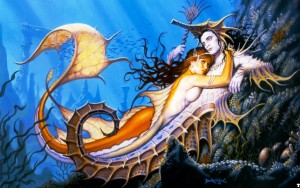
The crew of the Caleuche are drowned men, whose bodies are taken from the sea and are brought to the ship. Some versions say that they are horribly transformed in the process. Their guides are three mythological figures who are siblings and merfolk – the sirena chilote, the pincoya and their brother the pincoy. These are the children of the Millalobo, the Sea-King. (Chilote legends deserve an article in their own right, but that’s for another time).
In 2012 Jorge Olguin directed the film Caleuche: El Llamado del Mar (The Call of the Sea). Unfortunately there doesn’t seem to be an English language/subtitle version available, but as far as we can tell, the story concerns a marine researcher with Chilean roots who develops a disfiguring and unknown disease. She leaves the US to try and find a cure or explanation on the island of Chiloe, where her ancestors came from. There she discovers the legend of the Caleuche, and its effect on the lives of everyone there…
The film seems to be a blend of folk mythology and Lovecraftian dread, and looks rather interesting. Here’s the trailer:
As we can’t doggy-paddle much longer, we’ll bring things to a close. Normally we like to add a bit of music or audio, but space is limited. Jethro Tull and Tori Amos have both done Flying Dutchman songs, which aren’t bad, but the greatest one is Hugo Winterhalter & His Orchestra – The Flying Dutchman Ahoy Ahoy. If you can find that, you’re laughing (or sobbing, depending on your musical tastes). If you’re keen on some nautical horror to listen to, then we recommend William Hope Hodgson’s The Ghost Pirates, which is better than any Dutchman story we’ve encountered so far:
We leave you with a game that makes no sense to us, the Cub Scout game Flying Dutchman. No wonder our children are confused.
Instructions: Stand in circle facing inward holding hands. Two scouts hold hands outside the circle and are the Flying Dutchman. They circle the world, looking for a harbor in which to rest.
As they walk around the circle, the Flying Dutchman slaps the handhold of two scouts. Those two scouts must leave the circle as a pair and run around the circle in the opposite direction as the Flying Dutchman.
Whichever pair reaches the opening again first, reaches safe harbor. The other pair is now the Flying Dutchman.

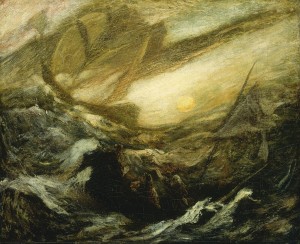
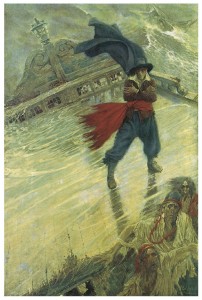
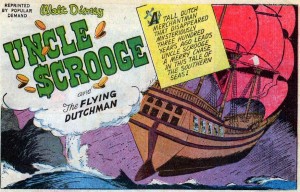
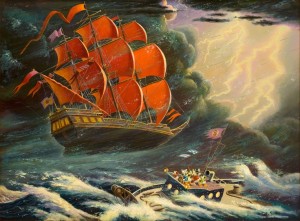
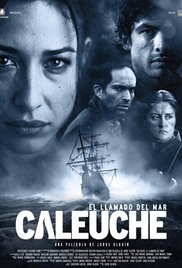
Thanks for the puppies….now that you’ve creeped me out.
We do our best!